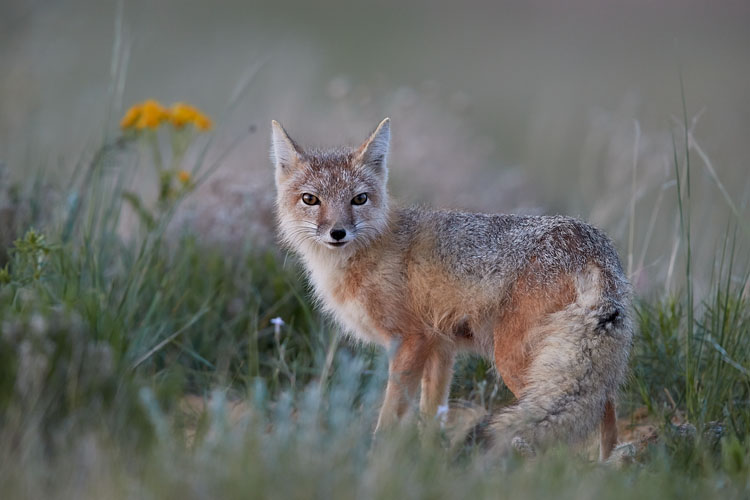Home > Blog > June 12, 2016 – Swift Fox Vixen, Pawnee National Grassland, Colorado and the Canon EOS 1D X Mark II
June 12, 2016
Swift Fox Vixen, Pawnee National Grassland, Colorado and the Canon EOS 1D X Mark II

Swift Fox Vixen
Pawnee National Grassland, Colorado, USA
Canon EOS 1D X Mk II, 600 f4 IS II & 2x III, 1/125 sec, f8, ISO 1600
Image taken on June 2, 2016.
Jan had arrived a couple of days before I did and found a den, so I was able to go straight into shooting mode instead of searching mode. (Thanks Jan!) This is the vixen on my first afternoon at the den, and she was quite relaxed with us around. It took her four kits longer to get accustomed to us, and I'll be showing you those cuties soon.
Canon EOS 1D X Mark II
I used my new Canon EOS 1D X Mark II to photograph the swift foxes, and it was fantastic! The biggest improvement over the Canon EOS 1D X (Mark I) is the autofocus system where all 61 points are active for f8 lenses, like my 600 f4 with a 2x tele-extender attached. In the past, only the center focus point was active for an f8 lens which required focusing on the subject and reframing when possible or tracking a moving subject and then cropping to get a better composition. The Automatic selection AF (all 61 points) also has better subject discernment and tracking to lock on and follow a subject when there is clutter between the camera and the subject. Because the new AF system is so good, I was quite happy to use my 600 f4 IS II and 2x III almost exclusively when photographing the foxes. There was no need to switch to the 1.4x III to get a better focusing system. This allowed me to get frame-filling shots while maintaining more distance from the den and thus putting less stress on the subjects.The sensor also has improved higher-ISO capability, so I was comfortable shooting at a maximum ISO 3200 instead of ISO 1600 for the 1D X (Mark I). The small boost in megapixels from 18 to 20 is nice as is the boost in frame rate from 12 fps to 14 fps. The significantly-increased buffer is a major improvement. The 1D X (Mark I) could handle about 32 RAW images and the 1D X Mark II can handle about 55 RAW images with a CF card and about 170 images with a CFast card. I had occasionally maxed out the buffer with the 1D X (Mark I), and with the Mark II it is essentially a non-issue.
The body feels great in the hand. The grip fits better and the multi-controllers (joysticks) have a much larger tip which is easier on the thumb. For some reason, the Quick Control Dial didn't feel as comfortable at first, but after a few days of shooting it feels fine.
Another great change is the spring on the card slot cover to keep the cover in the fully-open position so you no longer have to "re open" the door.
If you have been thinking about getting a Canon EOS 1D X Mark II to photograph wildlife, I can't recommend it enough.
Categories:
This particular blog entry is www.jameshagerphoto.com/blog/?date=2016-06-12. Visit www.jameshagerphoto.com/blog to view the latest blog entry, and you may click here to create a URL that you can bookmark to go to the latest blog entry.




